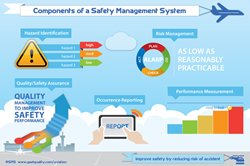Sextant Readings solution to support Airport safety self-inspection programs. Our solution will allow you to submit safety self-inspection information and create a single shared information environment to collect, analyze and report. Safety Self Inspection is a critical cornerstone to establish and maintain an effective safety program.
Airports must reliably perform day-in and day-out while dealing with different and changing conditions, all while maintaining a relentless focus on safety. To address these challenges, many airports are seeking Safety Self Inspection Software to support operations and maintenance personnel on the Air Operations Area of the airport in submission of information into an electronic database. The information in the database will then be used for analysis, action, follow-up and reporting as well as sharing with the FAA and other regulatory bodies.
Airports are not alone in seeking out a software application to support safety self-inspection and to create the foundation for a well implemented Safety Management System. Industry Associations and Regulators see a structured, risk-based approach to managing safety which incorporates safety into the fabric of the day-to-day decision-making process of an organization as an essential step in establishing a vibrant safety program. Sextant Readings provides the essential tools to enable Airports to establish a structured, risk-based safety management system based on the capture of Self Inspection information.
Sextant Readings is actively involved in the on-going evolution of Safety Management Systems. It actively participates in the FAA SMS Working Group, ensuring access to the most current SMS information available and influencing the direction of the rulemaking process. We are also actively involved in SMS activities across multiple aspects of the Aviation industry, including Airports, Air Carriers, Maintenance Repair and Overhaul (MRO) facilities and private, non-scheduled and public use operators. As a result, we apply holistic, best practices approaches to achieving best value from your safety management software investment as well as the processes and training required for its successful implementation.
Sextant Readings Solutions will provide world-class Safety Management information system software. In addition, Sextant Readings and partner with leading-edge GIS consulting firms that have been assisting airports throughout the Unites States with leveraging the power of GIS technology. They apply geographic knowledge to move clients into a position where GIS technology can be used in the decision-making process.
Sextant Readings partners with recognized leaders in the development and support of safety, quality and compliance management software solutions.
We support a broad range of Safety Management System needs. We enable you to (i) collect safety data; (ii) identify non-conforming situations and hazards; (iii) track, report, and access risk: (iv) assign responsibility for corrective action/ preventive action; and (v) manage workflow. We provide robust analysis capability with real-time graphical presentations. It integrates with your existing email and network environment to provide active notification and escalation communications based on user-defined thresholds. Its integration of customer complaint management, suppliers, employees and assets into a single data system to deliver an unmatched capability to monitor and manage safety across all your operations. We effectively support voluntary and confidential reporting including RSAP (Ramp Safety Action Programs), enables mobile devices (Documents, Audits, Reports), and supports airport self-inspection and Emergency Response Planning programs.
The combination of (i) your proprietary business knowledge and processes; (ii)Sextant Readings’ project management expertise, industry knowledge and experience; (iii) GIS enablement and (iv) award-winning software and services will produce the best return to your organization and its stakeholders for the investment in a Safety Self Inspection software solution.
Through our partnerships, Sextant Readings provides Airports with a single source for safety management software and the implementation services to align with your business processes and safety self-inspection program. We also train your team to maintain and modify the software configuration to maintain alignment with your safety program as you undergo continuous improvement. As your partner in the implementation journey, Sextant Readings will also support you with user training and on-going support services.
Sextant Readings’ approach to meeting your airport’s objectives is to provide and successfully implement a realistic, well-structured and professionally executed safety self-inspection solution. We believe that methodical planning and the delivery of the software solution in carefully managed and measured stages will ensure a successful, on-time delivery and implementation of the software.
Sextant Readings’ people drive our success. The experienced management team has extensive knowledge of compliance, safety, quality and risk management principles. Sextant Readings develops its employees and invests heavily in their training. This ensures its people not only possess the appropriate knowledge and skills, but also can meet and overcome new challenges. Sextant Readings views its investment in its employees as an investment in its business future.
Sextant Readings appreciates the opportunity to present our solutions to Airports and we look forward to a long and successful business relationship.


 For the first time in 30 years, ICAO are set to release a new Annex – Annex 19 – that pulls together current safety management practices and future expectations for facilitating safety risks that exist in our lands and skies.
For the first time in 30 years, ICAO are set to release a new Annex – Annex 19 – that pulls together current safety management practices and future expectations for facilitating safety risks that exist in our lands and skies.